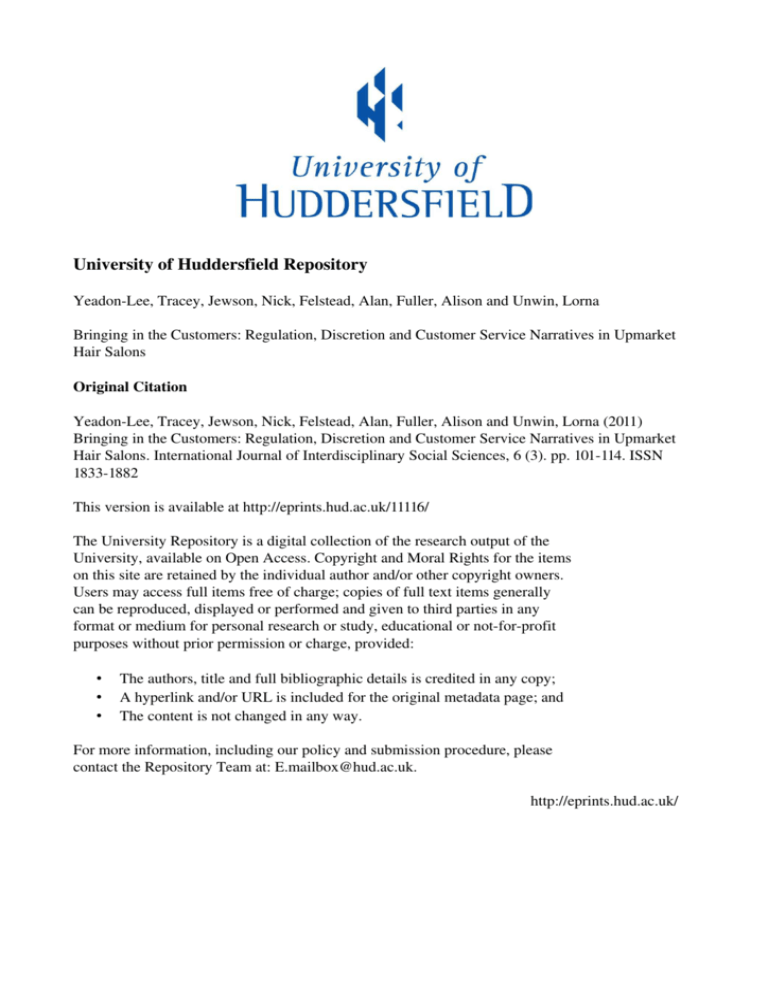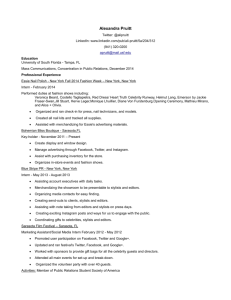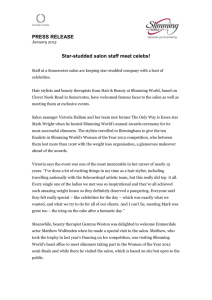- University of Huddersfield Repository
advertisement

University of Huddersfield Repository Yeadon-Lee, Tracey, Jewson, Nick, Felstead, Alan, Fuller, Alison and Unwin, Lorna Bringing in the Customers: Regulation, Discretion and Customer Service Narratives in Upmarket Hair Salons Original Citation Yeadon-Lee, Tracey, Jewson, Nick, Felstead, Alan, Fuller, Alison and Unwin, Lorna (2011) Bringing in the Customers: Regulation, Discretion and Customer Service Narratives in Upmarket Hair Salons. International Journal of Interdisciplinary Social Sciences, 6 (3). pp. 101-114. ISSN 1833-1882 This version is available at http://eprints.hud.ac.uk/11116/ The University Repository is a digital collection of the research output of the University, available on Open Access. Copyright and Moral Rights for the items on this site are retained by the individual author and/or other copyright owners. Users may access full items free of charge; copies of full text items generally can be reproduced, displayed or performed and given to third parties in any format or medium for personal research or study, educational or not-for-profit purposes without prior permission or charge, provided: • • • The authors, title and full bibliographic details is credited in any copy; A hyperlink and/or URL is included for the original metadata page; and The content is not changed in any way. For more information, including our policy and submission procedure, please contact the Repository Team at: E.mailbox@hud.ac.uk. http://eprints.hud.ac.uk/ Bringing in the Customers: Regulation, Discretion and Customer Service Narratives in Upmarket Hair Salons Tracey Yeadon-Lee (A), Nick Jewson (B), Alan Felstead (B), Alison Fuller (C), & Lorna Unwin (D) A) Department of Behavioural & Social Sciences, University of Huddersfield, UK; B) Cardiff School of Social Sciences, Cardiff University, UK; C) School of Education, University of Southampton, UK; D) Institute of Education, University of London, UK Address for Correspondence Dr Tracey Yeadon-Lee University of Huddersfield Department of Behavioural & Social Sciences Ramsden Building Queensgate Huddersfield HD1 3DH Email: t.yeadon-lee@hud.ac.uk Bringing in the Customers: Regulation, Discretion and Customer Service Narratives in Upmarket Hair Salons Abstract This paper explores the work of UK hair stylists in ‘up-market’ hairdressing salons and examines the connection between the organisation of work and customer service narratives within these salon environments. Drawing on qualitative empirical research, the paper discusses how tensions, generated through managerial regulation and the concomitant requirement for stylists to exercise task discretion, are ultimately reconciled through customer service narratives. The paper argues that while the narratives achieve this by operating as a form of normative regulation in the salons, whereby the work practices of stylists are shaped in line with organisational goals and objectives, they also function as resources for stylists through which they can further their economic and occupational selfinterests. Keywords: Hairdressing, Management control, Management Regulation, Work Practices, Customer Service Narratives Introduction To date, little is actually known about hairstyling as a specific form work. While some studies explore dimensions of gender, ‘race’ and class within hairstyling salons (Gimlin, 1996; Black, 2004; Sharma and Black, 2001; Lindsay, 2004), few studies have focused directly on the work being done by stylists and, specifically, how this connects to organisational structures, cultures, the relationships between employers and stylists and stylist’s occupational identities. The aim of this paper is to stimulate further research and discussion in this area by exploring the work of UK stylists in ‘up-market’ hairdressing salons. In the following discussion we examine the connection between the organisation of work and customer service narratives within these salon environments. Drawing on qualitative empirical research, we discuss how tensions, generated through managerial regulation and the concomitant requirement for stylists to exercise task discretion, are ultimately reconciled through customer service narratives. We highlight how these narratives operate as a form of normative regulation within the salons, shaping the work practices of stylists in line with organisational needs and objectives. However, we take issue with existing ‘critical’ accounts of workplace regulation which, based upon a negative conceptualisation of power, argue that 1 managerial regulation is a wholly negative and restrictive phenomenon that subjugates employees (Collinson, 2003). Rather, we take a ‘productive’ approach to power which sees power as enabling as well as constraining (Cooper, 1994) and, in the analysis of the interviews, argue that although the narratives have a regulatory function they also operate as ‘productive’ discursive resources, enabling stylists to forge particular identities and take up specific subject positions through which they can further their individual and occupational self- interests. The first section of the paper offers a brief overview of the research on which this paper is based. This is followed by a brief examination of the nature of service work and contemporary literature concerning managerial control and regulation. Our empirical findings are presented in subsequent sections which address the forms of control and surveillance that operated in the salons, customer service narratives and the role-related performances of aesthetic labourer, consultant/educator and sales person which, in being shaped by the narratives, enabled stylists used to construct their identities and further their interests. The Research In the UK it is estimated that there are some 36,000 hairdressing salons, employing over a quarter of a million staff (Skills Active & HABIA, 2008). Most are small, independently-owned businesses, situated in local neighbourhoods. However, larger salon chains – many of which are franchised – are steadily increasing in number (Skills Active & HABIA, 2008). These tend to be located in busy urban centres, charge higher prices and have a reputation for high fashion and innovation in techniques and styles (Drucker et al, 2002). Many invest heavily in training, running ‘in-house’ training schools for apprentices (Mintel, 1999). Existing academic research and literature, however, has almost exclusively focused on small independent salons. As yet, few studies have extended their focus to include the larger high fashion and/or ‘upmarket’ firms. The discussion in this paper aims to bridge this gap by drawing on qualitative empirical research carried out in four franchised hair salons belonging to two medium sized ‘upmarket’ hairstyling organizations in the Midlands, UK. This research was undertaken as part of a broader study of learning processes in contemporary workplaces where areas of investigation covered organisational structures, cultures and relationships as well as learning processes.1 Within the hairdressing organisations, in-depth interviews were carried out with staff at all levels and included company directors, senior managers, salon franchisees/directors, salon managers, company trainers and hair stylists of various grades. The interviewees ranged from their early twenties to mid-fifties and all were white. A total of 2 forty-nine interviews (including thirty-eight stylists) were conducted. Fourteen of the interviewees were male (ten stylists, two company directors, two trainers) and thirty-five were female (twenty-eight stylists, two company directors and five salon franchisees/directors). All interviews were tape-recorded, transcribed, coded and analysed using Atlas.ti. The interviews were supplemented by non-participant observation in the salons and also two training events. In-house documents and paperwork were also collected and analysed as part of the research. The names of the companies, salons and associated staff are replaced with pseudonyms. ‘The Haslam Hair Company 1’ and ‘The Haslam Hair Company 2’ are part of ‘The Haslam Hair Company’ franchise and the salons ‘Clarke Anthony’ 1 and ‘Clarke Anthony’ 2 form part of the ‘Clarke Anthony’ company. Service work: an overview ‘Advanced’ or ‘late’ capitalist economies have been characterized by the rise of the service sector and the growth of personal service occupations (Macdonald and Sirianni, 1996; Korczynski & Macdonald, 2009). Service work, broadly defined, is ‘when the process of being served is as much a part of the sale as any physical products’ (Grugulis and Vincent, 2009: 599), Notwithstanding the growth of low level, low skilled service jobs, commonly referred to as ‘Mc jobs’ (Ritzer, 1998), affluent consumers have generated demand for highquality and high-cost personal services (Ransome, 2005). Examples where such services might be provided include upmarket hotels, clubs, restaurants, resorts, fitness centres, sport facilities, bars, boutiques, beauticians and hairdressers. These venues place an emphasis on individualized or customised services rather than the standardisation and predictability, usually found in low level services within the service sector, such as in fast food outlets. High cost personal services typically address the desires rather than the material needs of customers and thus spectacle and themeing are often used to enhance the service environment, or ‘servicescape’ (Bitner, 1992), ‘enchant’ customers (du Gay, 1996; Bryman, 1999) and provide a unique ‘experience’ (Wayne, 2010). Services of these kinds typically entail the organization, delivery and management of emotional labour (Hochschild, 1983; Wharton, 2009) or emotion work (Bolton and Boyd, 2003; Bolton, 2005), where employees are required to manage their emotions in order to positively affect the feelings of customers and clients; and aesthetic labour, where employees are recruited and/or trained to look the part - to embody the desired look and image of the organization (Nickson et al, 2001; Witz, et al, 2003). Competitive advantage 3 derives from the fashionable cachet attached to service outcomes and the ambience that surrounds the service location, resulting in an emphasis on quality and the social psychology of ‘customer care’ (Gutek, 1999; Gutek et al, 2000; Wayne, 2010). Service work and control/surveillance The nature and operation of managerial control and regulation is a dominant theme in many studies of service work (Korczynski and Macdonald, 2009; Sturdy et al, 2001). This is largely discussed in relation to what is seen to be two contradictory logics that lay at the heart of service work organisations: ‘the logic of bureaucratisation, of cost-minimisation and/or efficiency and profit; and the logic of customer-orientation, of needing to structure work to appeal to customers not just through price but also through service quality’ (Korczynski, 2005: 8). On the one hand, the requirement to be profitable prioritises labour productivity, operational efficiency and cost minimization. On the other, the requirement to ‘enchant’ customers and/or offer good customer service highlights the intangible, experiential aspects of service encounters which deliver high quality and individualized experiences (Gabbott et al, 1998). Tensions occur as both logics present service organisations and workers with contradictory and conflicting imperatives. For example, the achievement of high labour productivity, efficiency and cost minimization is generally established through predictability and standardization in service encounters, (as can be seen in many fast food outlets). However, this is not conducive to the provision of high quality service, where the aim is to ‘enchant’ customers through services that are individualised and customised. This, then, creates a tension in how work is organised and managed. While predictability and standardization lead to bureaucratic forms of managerial control such as imposed rules, regulations and mechanisms of surveillance, the requirement to establish customer ‘enchantment’ calls for high levels of worker discretion (Rosenthal, 2004; Korczynski, 2009). In high quality service industries there is thus an uneasy alliance between rule-governed efficiency and the provision of personalized customer care. The challenge for such organizations is to manage and contain this and achieve a degree of continuity and integration. Existing discussions, that draw on labour process theory and also Foucauldian frameworks of power and discourse, emphasise how high quality services meet this challenge by employing management strategies that facilitate normative, cultural forms of control and regulation. The aim of such strategies is to control/regulate from ‘within’, where the task of managers is to win the hearts and minds of employees so as they become self-controlled, self-disciplined and internalise or ‘buy in’ to organisational culture and values (see, inter alia, 4 Alversson et al, 2002; Rosenthal, 2004; Willmott, 1993; Casey, 1995; duGay, 1996; Gabriel, 1999). A major argument, which adopts a negative conceptualisation of power, is that these forms of control and regulation are coercive, restrictive and subjugate employees (see, for example, Collinson, 2003 and Casey, 1995). However, recent shifts in conceptual thinking have sought to acknowledge and reveal employee agency and resistance within management/employee/customer relations (Gabriel, 1999; Bolton, 2005; 2009) and also the ways in which management control mechanisms may be seen as ‘productive’ as well as a constraining for workers. Rosenthal (2004: 617-18), for example, argues that the negative perception of power underpinning many contemporary theories of control have ‘overemphasized the uniformity, magnitude and malign effects of management control for workers’ and that ‘[r]esearch might also consider the conditions under which control forms are likely to function as a resource in the pursuit of interests, however defined’.2 In the remaining discussion this consideration is fully explored in the context of the empirical research carried out in the salons. The Salons: bureaucratic and normative controls in the workplace The organisation/structure of work Managerial relationships within the four hairdressing salons studied in our research were complex, involving interdependencies between the franchisor organisations, franchisees/salon directors, salon managers, stylists and clients. Stylists were accountable to franchisees, who were themselves subject to regulation by franchisor companies to ensure compliance with company-wide standards. Franchisees in all four salons were former trainees or employees of the chain.3 They paid a percentage of salon takings to the parent company and held renewable contracts lasting several years. They were required to conduct their businesses within strict parameters laid down by the franchisor organization, including adherence to employment policies, training provision, product use, sales, promotional and marketing materials, staff demeanour and also the interior design and overall look of the salons. Centralized business systems were provided and managed by the head offices of the franchisor organizations. These included the administration of performance indicators, financial accounts, wages and salaries, marketing campaigns and IT. Franchisor companies also provided a pool of business consultants and extensive training facilities. Within the salons, stylists were subject to a variety of forms and channels of control, incorporating distinctive devices, texts and disciplines. Prominent among these were: league tables; regulations concerning salon decor; service encounter regulations; and normative codes and values. Monthly league tables compared the financial performance and work 5 output of individual stylists in all the salons within franchisor chains. They were compiled by franchisors, distributed to franchisees and made openly available to salon staff. Statistics, covering a wide range of detailed indicators, not only ranked the performance of stylists within salons but also compared them across the group. Stylists were, thus, under some pressure to compete with peers. Customer Care In the interviews, observations and various organisational documentation, such as salon web sites and other promotional material, both organisations displayed a strong commitment to, and ethos of customer service ‘excellence’ (Austin-Smith, 2007). At a basic level this involved franchisees and all stylists creating a desirable (fashionable and high quality) environment for the consumption of services and products.4 This meant adhering to dress codes and maintaining high standards in relation to the material environment of the salon (or the ‘servicescape’).5 This was achieved through everyday routines and practices which attended to aesthetic appearance, such the way equipment was placed and stored at workstations, how towels and gowns were folded and arranged, how products were displayed on the shelves as well as other activities such as general tidying and cleaning.6 While expectations and standards surrounding these activities were set by the franchisors, other working practices that involved social interaction with clients were also prescribed. Guideline booklets on ‘customer care’ provided minute instructions on the conduct of telephone conversations, greetings and departures, consultations, hair washing and cutting etiquette, after-care advice and maintenance of customer records. These practices were monitored by franchisors via ‘mystery shoppers’, customer satisfaction questionnaires and also ‘courtesy calls’. Through these techniques managerial control was potentially broadened in scope as clients were placed as central agents in the service encounter, positioned to take on a regulatory role in the service relationship (Fuller & Smith, 1991). Thus, while both organisations had tight, ‘bureaucratic’ management control systems, where the overall performance of the salon service areas and working practices of stylists were specified in rule books, these were also embedded within salon norms.7 Culture and the Customer: Service excellence and stylist discretion in the Salons While meeting and maintaining company ‘standards’ was important, both organisations required stylists to go beyond these basic forms of customer care in order that their services stood out from those provided in other salons. Achieving ‘service excellence’ and providing high quality individualised services for salon clients also meant that they required stylists to 6 exercise discretion and express individuality in their work. Senior directors and managers in both organisations were equally emphatic concerning this need: … (in) McDonalds where everything is identical … each restaurant looks the same, the menu is the same, the staff look the same. We’d never do that because this is a creative business and you have creative people at the helm, and they have their own visions, they have their own ideas. So you have to give them a bit of latitude. (Gerry, Director, Clarke Anthony) I believe that we should have the qualities and the skills and the behaviours and the thought processes that fit with the culture but at the end of the day the last thing I would want is a load of clones. How we do it, the style we have is down to the individual. I would hate for people to be a [company] clone ... my goal is for each individual to be themselves. (Rhiannon, Senior HR Manager, The Haslam Hair Company) For these organisations, the need for stylists to exercise discretion, autonomous decisionmaking and ‘be themselves’ was seen as crucial for their ‘creativity’ to be unleashed and put to work. However, as the above quote from Rhiannon illustrates, the opportunity for each stylist to ‘be themselves’ within this process was contingent on their ‘fit’ with the culture of each organisation. For both organisations this was ultimately managed through a master narrative of customer service excellence, where notions of ‘delighting’ and ‘wowing’ clients through service provision was emphasised as being crucial to the success of both stylists and the salons. The narratives of ‘delight and wowing’ were understood to involve salons and stylists ‘exceeding’ the expectations of clients and, in so doing, achieving differentiation from company rivals. To ‘delight’ and ‘wow’ was conceived primarily as positioning the client as a ‘sovereign consumer’ (e.g. the customer is queen/king) (duGay 1996; Gabriel and Lang, 1995; Gabriel, 1999), and engaging in work-related activities in relation to clients that generate particular emotional states, such as wonder, pleasure and a sense of high status, which could inspire staff and thrill clients. The ideas of ‘delight’ and ‘wowing were most clearly articulated by the managers within the two organisations: … it’s about the coffees, the magazines, the gowning up, the way the place looks, the cleanliness, the standards – that’s the tangible 7 things, the kind of things you can touch. The intangible things … it’s about the atmosphere, the attitude of people, the way people talk to the customers. (Rhiannon, Senior HR Manager, The Haslam Hair Company) ...its trying to exceed their expectations, doing something that’s different, that we hope that they’re going to enjoy and talk about and want to come back and have more of. (Zoe, Franchisee, The Haslam Hair Company 2) It’s about having the skills to make the judgements that will create delight in every individual customer. (Rhiannon, Senior HR Manager, The Haslam Hair Company) These narratives, embedded in the experiences and intuitive practices of interaction work within salons, constituted powerful channels of normative and cultural control by management as the individual personas, performances and discretionary practices of stylists were harnessed and brought into line with organisational goals and objectives. However, the narratives were not simply imposed from above upon a passive or recalcitrant workforce. In all the interviews carried out with stylists, the narratives were actively embraced and positively articulated by stylists.8 In and through these narratives, stylists constructed a sense of style, status and expertise which not only contributed to the success of the salons but enabled stylists to establish a form of ‘occupational capital’ within (and beyond) the salon. The work practices of stylists that were particularly influenced by and shaped through the narratives, and which required significant levels of discretion, required stylists to engage in a variety of role-related performances which included: aesthetic labourer, consultant/educator and sales person. The Stylist as Aesthetic labourer Within hairdressing, it is well documented that customers expect more from their appointments than a good haircut and that salons are very aware of the importance of the appearance and demeanour of staff, as well as the milieu of the salon (Skills Active & HABIA, 2008). In both organisations, the image of stylists was part of the branding of the salons: stylists were required to project a ‘stylish’ corporate image in keeping with the salon surroundings but, at the same time, emphasise their individuality and personality. Neither 8 organization had a set uniform or particular style of dress. However, stylists were required to wear clothing in a limited and particular range of colours. Clothing had to be clean, smart, fashionable and in keeping with the stylish corporate image. Hair was also considered to be an important part of the ‘look’. Stylists were encouraged to cut and style one another’s hair, keeping it up to date with new fashions in styles, cuts and colours. Both ‘looking good’ and ‘sounding right’ were considered to be essential attributes of their appeal to clients and thus valuable economic assets (Warhurst et al, 2001; Lindsay, 2004; Cohen, 2005). The personal aesthetic labour of stylists, however, was not only integral to the success of the salons, where the images and visual personalities of stylists’ enhanced the salon service areas in order to delight clients, but also to their own reputation and career development, as one stylist remarked: … we attract different clientele through our kind of personalities … that makes it interesting. I’d say it’s very important to look the part. (Harry, Stylist, The Haslam Hair Company 2) Throughout the interviews with stylists, discussions around aesthetics, both in terms of their appearance and that of the salon, revealed how the processes of ‘delight and wowing’ also extended to them as well as to the clients. By participating in the fashionable aesthetics afforded to them by the workplaces they, like the clients, shared in the high status of the salon. One stylist, for example, highlighted how important the ‘fashionable’ reputation of the salon was to her: … it’s always been fashionable. When I started it was, you know, purple with purple curtains and purple seats, which at the time was really quite trendy. So I mean they’ve always kept up with fashion. I’m always proud to say I work here, I always have been and I still am. (Fiona, Stylist, Clarke Anthony 1) Through the fashionable and high quality status of the salon the distinction between production and consumption became blurred. Thus, the fashionable cachet of the salon functioned as a significant resource in stylists’ production of their stylish and ‘trendy’ identities. While this afforded them status within the salon, enabling them to attract and establish clientele, it also extended beyond the workplace to relations with peer groups and other occupational ‘community’ members such as stylists from other salons. Thus, while their 9 aesthetic labour had commercial benefit for the salons it was also highly beneficial to stylists, enabling them to develop a sense of taste and style and establish occupational aesthetic capital. The Stylist as Consultant/Educator Emotional labour (Hochschild, 1983) or emotion work (Bolton, 2005) was a key element in the stylists’ work and underpinned almost all of the work practices and role performances that were geared towards delighting and wowing clients. One particular practice where it was especially crucial was the ‘consultation’ - the stage during an appointment where, after initial greetings, stylists discuss cuts, styles and other hair requirements, such as colours, with the client. From the descriptions of consultations that were given during the interviews, it was apparent that stylists exercised a significant degree of discretion. Although clients expressed their own preferences in this exchange, stylists described their role as one of making alternative suggestions, drawing attention to the latest fashions and techniques and offering personal advice. This entailed making general assessments about the personality, age, lifestyle and social status of clients as well as more specific attributes such as their facial shape, skin tone and hair characteristics. While in both organisations, the dynamics of consultations were discussed in training courses, hedged around with etiquette rules specified in guidance documents, the consultation itself could not be reduced to a formulaic calculation or preset script. It required judgement and constituted an irreducible sphere of discretion intrinsic to high-fashion, high-cost hair care, as one company trainer remarked: We like to do consultations without you wearing your gown because what happens is the gown … covers you all up. And I can’t see you, or your personality, or your sense of style, your clothes, or your personal image. (Ben, Head of Training, The Haslam Hair Company) The consultation itself, as other authors have noted, is crucial in establishing trust with clients, cultivating rapport, offering hair care and style advice and securing repeat bookings (Eayrs, 1993; Soulliere, 1997; Gimlin, 1996, 2002; Parkinson, 1991). However, throughout our interviews with stylists it was apparent that they also functioned as a platform through which stylists could exhibit their knowledge and expertise and so enhance their occupational identity and standing. Rather than seek to establish rapport by engaging in mundane conversations with clients, such as the latest holiday or evening out, these stylists took the 10 opportunity to promote the salon and themselves. This entailed getting clients to become involved in the service and interested in the culture and life of the salon. As one stylist I think they feel at home here because you get them involved in what’s going on in the salon … what’s the latest thing what we’re doing … what we’re talking about at the moment. (Ursula, Stylist, The Haslam Hair Company 2) ‘Involving’ clients was not, however, restricted to making them aware of the latest promotions and offers. Both organisations actively encouraged stylists to make clients aware of their career development achievements - any qualifications they were working towards, courses they had undertaken or competitions they had entered and/or won. This communicated to clients that the salons invested in the stylists’ development and that stylists were ‘keeping up’ with new trends and techniques, and so quality service was consistently being provided. One stylist, for example, reported that: [courses] keep me up to date and so I say to my clients “oh I have been on a creative cutting course”. I’ve been on one in January, because everyone goes on one that’s one that’s twice a year, went on a couple last year so you’re always improving like your skills and your knowledge. (Ursula, Stylist, The Haslam Hair Company 2) In making clients aware of such achievements stylists provided a ‘wow’ for their clients and at the same time legitimized the high costs of the hair care being provided. While this enhanced the professional image and fashionable cache of the salon it also had the further advantage of enabling stylists to construct a sense of expertise and legitimate professional status. For stylists, this was a useful aid to gaining new clients, as well as keeping regulars, but was also particularly helpful when dealing with ‘difficult’ clients, as one stylist recalled: … one woman said ‘I want this, you do know how to do this don’t you’ … then you just come across with your qualifications and what you have got, and say ‘well I have got the highest qualification, I’ve been to finishing school’ and then what does shut them up is when you do finish their haircut and then they’re like ‘okay, she does know what she’s doing’ (Ursula, Stylist, The Haslam Hair Company 2) 11 ‘Involving’ clients also included educating them about hair care, technical procedures and products being used on their hair whilst in the salon. This encouraged clients to become more ‘knowledgeable’ and thus more active in their consumption of the service: to be more aware of the array of possible procedures and products when discussing their hair requirements, for example, colour. Advising clients when new techniques and products were being made available within the salon also ensured that clients would be encouraged and be given ample opportunity to try out new styles, colours and techniques and also make new product purchases. As one stylist commented: … hairdressing is always changing and stuff. And different techniques are always coming in. So they should kind of keep up with that, just so they know what’s new. (Veronica, Stylist, Clarke Anthony 1) By educating clients stylists were, moreover, able to position themselves as ‘experts’ and make visible to clients their on-going commitment to continuous learning and professional development. Both organisations invested heavily in formal training and other contexts that facilitated continuous technical and service-oriented learning and a commitment to ‘keeping up’ was regularly asserted by all of the interviewees. This was understood to be necessary due to advances in technical skills and the never-ending round of fashion trends, particularly in delivering high-cost, high-quality and high-style hair care. As one stylist explained: … it’s like being in the fashion industry … you need to be learning new techniques all the time. You don’t suddenly stop your training … Because things are changing, like, all the time. So you need to be…. kept on your toes … like always wanting to learn new things. Because every day there’s something new coming out. (Tricia, Stylist, Clarke Anthony 2) The stylist as Sales Person Significantly, the client ‘involvement’ practices that stylists engaged in also enabled them to justify and legitimize the calculative dimensions of their work, as economic rewards would be pursued as part of engaging in professional client care. Thus, through the narratives of 12 ‘delight and wowing’ stylists reformulated the idea of ‘selling’ products and services as, rather, making ‘recommendations’ in clients’ best interests. This was succinctly outlined by managers in both organisations: We don’t actually sell products as such ...it’s more recommending and talking about the products (Sarah, Salon Manager, The Haslam Hair Company 2) This client has just spent seventy odd pounds on a colour ... don’t go home and wash it on something off the shelf that you don’t know you’re washing. ‘Cos you wouldn’t do it with a dear jumper, you know, you’d go home and hand wash it wouldn’t you? It’s the same with your hair. (Saskia, Franchisee, Clarke Anthony 1) Through the narratives of ‘delight and wowing’, ‘recommending’ a product to a client was thus seen as helping them get the best from the hair treatment they had purchased. This was seen to be in the best interest of clients as it added longevity to colours, thus saving them money, and also enabled them to successfully recreate their chosen hairstyles at home. Through this process stylists were able to make money, via the sale of recommended products, but also succeed in providing good quality service for their clients. In so doing, stylists were also able to establish and/or reinforce their ‘expert’ and professional status, as. one stylist demonstrated when describing her particular sales technique: … when a new product comes out you get told about … and with products anyway you can easily read the back of them and find out what their job is and just make out you know all about it. And then they’re like (the client) “oh God that sounds great, I might try some of that’ and you’re like, ‘oh well, I tell you what when I sit you down I’ll go and get them and you can have a look for yourself” and they’re like reading the back and they’re like ‘oh God, that’s just exactly what she said” (laughs). (Tina, Stylist, Clarke Anthony 2) Conclusion 13 In this paper we have examined how the contradictory logics of productivity/profitability and customer ‘enchantment’ was played out and managed across the managerial controls, work practices, and customer service narratives of hair salon staff in two medium sized franchised organizations in the UK. Franchisor companies and franchisees were shown to have drawn upon a wide range of bureaucratic modes of control, as well as institutionalizing a degree of autonomy whereby stylists could exercise discretion in their work. Normative, cultural control, where the conduct and discretion of stylists in their service encounters could be regulated, was shown to have operated directly through the service excellence narratives of delighting and wowing clients. Taking a productive rather negative approach to power, we have illustrated, however, that while the customer service narratives of ‘delight and wowing’ provided a channel for the operation of normative control within the salons, whereby the values, attitudes and discretionary practices of stylists could be brought into line with organizational objectives, that this was not detrimental to stylists’ interests and did not coerce, restrict and subjugate them. Rather, we have shown that the narratives constituted discursive ‘resources’ for stylists which enabled them to establish and legitimise a sense of professionalism and expertise, to make money through ‘caring’ for clients, to promote and make visible to clients their already held skills and knowledge and, moreover, highlight how, in an industry driven by changing fashions and technology this requires commitment to continually work on their upkeep and development. In a feminised occupation that continues to have a reputation for being low-skilled this has particular significance as it directly challenges the negative perception of hairdressing as a whole and provides justification for improved occupational status, material rewards and access to further training and development. Taken together, these can be seen to create a form of occupational capital for stylists, having value both within and beyond the workplace. References Austin Smith, A. (2007) The Fantastic Salon, London: The Fantastic Hairdresser Company Ltd. Alvesson, M. and Willmott, H. (2002) ‘Identity Regulation as Organizational Control: Producing the appropriate Individual’, Journal of Management Studies, Vol 39, pp. 619-644 Bitner, M.J. (1992) ‘Servicescapes: The impact of Physical Surroundings on Customers and Employees’, Journal of Marketing 56 (April): 57–71. 14 Black, P (2004) The Beauty Industry: Gender Culture, Pleasure, London: Routledge Bolton, S. (2001) ‘Changing faces: nurses as emotional jugglers’, Sociology of Health and Illness, 23 (1): 85-100. Bolton, S.C. and Boyd, C. ( 2003) ‘Trolley Dolly or Skilled Emotion Manager? Moving on from Hochschild’s Managed Heart’, Work, Employment and Society 17(2): 289-308 Bolton, S. (2004) Emotion Management in the Workplace, Houndsmill, Basingstoke: Palgrave Macmillan. Bolton, S. & Houlihan, M. (2009) Work Matters: Critical Accounts of Contemporary Work, London: Palgrave Bryman, A. (1999) ‘The “disneyfication” of society’ Sociological Review, 4 (1): 25-47. Casey, C. (1995) Work, Self, and Society. London: Routledge. Cohen, R.L. (2005) Styling Labour: Work Relations and the Labour Process in Hair Styling, doctoral thesis, University of California, Los Angeles. Collinson, D. L (2003) 'Identities and insecurities: selves at work', Organization, vol 10 (3), pp. 527 - 547 Cooper, Davina (1994) ‘Productive, Relational and Everywhere? Power and Resistance within Foucauldian Feminism’, Sociology, 28 . pp. 435-454. Cowen, E., Gesten, E., Boike. M., Norton, P. and Wilson, A. (1979) ‘Hairdressers as care givers. I. A descriptive profile of interpersonal help-giving involvements’, American Journal of Community Psychology, 7 (6): 633-48. Drucker, J., Stanworth, C. and White, G. (2002) Report to the Low pay Commission on the Impact of the national Minimum Wage on the Hairdressing Sector, University of Greenwich Business School. Du Gay, P. (1996) Consumption and Identity at Work, London: Sage. 15 Eayrs, M. (1993) ‘Time, Trust and hazard: Hairdressers’ Symbolic Roles’, Symbolic Interaction, 16 (1): 19-37. Fuller, L. and Smith, V. (1991) ‘Consumers’ reports: management by customers in a changing economy’, Work, Employment & Society, 5(1): 1-16. Gabbott, M., and Hogg, G (1998) Consumers and Services, London: Wiley Gabriel, Y. (1999) ‘Beyond Happy Families: A Critical Re-evaluation of the ControlResistance-Identity Triangle’, Human Relations 52, 2, 179-203. Gabriel, Y. and Lang, T. (2006). The Unmanageable Consumer: Contemporary Consumption and its Fragmentation. London: Sage (2nd edition) Gimlin, D. (1996) ‘Pamela’s Place: Power and Negotiation in the Hair Salon’, Gender and Society, 10 (5): 515-26. Gimlin, D. (2002) Body Work: Beauty and Self Image in American Culture, Berkley, CA: University of California Press. Gutek, B.A. (1999) ‘The social psychology of service interactions’, The Journal of Social Issues, 55 (3): 603-17. Gutek, B.A., Bhappu, A., Schneider, S. and Woolf, L. (2000) ‘Features of service relationships and encounters’, Work and Occupations, 27 (3): 319-51. Grugulis, I, & Vincent, S (2009) ‘Whose skill is it anyway? ‘Soft’ skills and polarization’, Work Employment & Society, December 2009 vol. 23 no. 4 597-615 Hochschild, A. (1983) The Managed Heart, Berkley: University of California Press. Korczynski, M. (2001) ‘The contradictions of service work: call centre as customer-oriented bureaucracy’, in Sturdy, A., Grugulis, I. and Willmott, H. (eds) Customer Service: Empowerment and Entrapment, Houndsmill Basingstoke: Palgrave. 16 Korczynski, M. (2002) Human Resource Management in Service Work, Houndsmill Basingstoke: Palgrave Macmillan. Korczynski, M. (2005) Skills in service work: an overview. Human Resource Management Journal, 15,2, 3–14. Korczynski, M. & Macdonald, C (2009) Service Work: Critical Perspectives, London: Routledge Lindsay, J. (2004) ‘Gender and class in the lives of young hairdressers: from serious to spectacular’, Journal of Youth Studies, 7 (3): 259-77 Macdonald, C.L. and Sirianni, C. (eds) (1996) Working in the Service Society, Philadelphia: Temple University Press. Mintel (1999) Hairdressing Salons and Barber Shops - UK - June 1999 Mintel International Group Limited. Nickson, D., Warhurst, C., Witz, A. and Cullen, A. (2001) ‘The importance of being aesthetic: work, employment and service organization’, in Sturdy, A., Grugulis, I. and Willmott, H. (eds), Customer Service: Empowerment and Entrapment, London: Palgrave, pp170-90. Notkin, M.S. (1972) ‘Situational learning in a school with clients’, American Behavioral Scientist, 16 (1): 45-54. Parkinson, B. (1991) ‘Emotional stylists: strategies of expressive management among trainee hairdressers’, Cognition and Emotion, 5 (5-6): 419-34. Pettinger, L (2004) ‘Brand Culture and Branded Workers: Service Work and Aesthetic Labour in Fashion Retail’, Consumption, Markets and Culture, Vol. 7, No. 2, June, pp. 165– 184 Pettinger, L. (2006) ‘On the Materiality of Service Work’, Sociological Review. 54 (1) pp 4865. Ransome, P. (2005) Work, Consumption and Culture: Affluence and Social Change in the Twenty-first Century, London: Sage. 17 Ritzer, G. (1998) The McDonaldization Thesis, London: Sage. Rosenthal, P. (2004) ‘Management control as an employee resource: The case of front-line service workers’, Journal of Management Studies, 41, 4: 601-622. Sharma, U., Black, P. (2001), "Look good, feel better: beauty therapy as emotional labour", Sociology, Vol. 35 No.4, pp.913-31. Skills Active in Association with HABIA (Hair and Beauty Industry Authority) (2008) Assessment of Current Provision: Hair and Beauty Sector, January 2008, Doncaster: The Hair and Beauty Industry Authority. Soulliere, D. (1997) ‘How hairstyling gets done in the hair salon’, Michigan Sociological Review, 11 (Fall): 41-63. Sturdy, A., Grugulis, I. and Willmott, H. (eds), Customer Service: Empowerment and Entrapment, London: Palgrave Wayne, A.., M,. (2010) Customer Delight: A review, Academy of marketing Studies Journal, Vol 14, No. 1 2010, pp. 39-54 Wharton , A. S. (2009) The Sociology of Emotional Labour, Annual Review of Sociology, Vol 35: 147-65 Willmott, H. (1993) ‘”Strength is ignorance; slavery is freedom”: managing culture in modern organizations,’ Journal of Management Studies, 30 (4): 515-52. Witz, A., Warhurst, C. and Nickson, D. (2003) ‘The labour of aesthetics and the aesthetics of organization’, Organization, 10 (1): 33-54. 1 The research was undertaken as part of a broader research project, funded by the Social and Economic Research Council in the UK, concerned with learning processes in the work place. For details see: http://www.tlrp.org/proj/phase111/felstead.htm 2 As Rosenthal (2004) points out, researchers have been aware for some time that employees may experience some forms of management control as congruent with their own interests - see, for example, Buroway (1979) and Leidner (1993). However, this issue has yet to be adequately addressed and researched. 3 Controls were further embedded into organisational the structures as both organisations employed a system where franchising was not generally made available to outsiders, only to suitable salon managers who had 18 trained and worked in the organisation itself. As one director of The Haslam Hair Company explained, this strategy was effective in making sure that those running the company salons had ‘the right mind set’ for the organisation. 4 For a discussion of the significance of how service workers engage with material products, as well as with customers and clients, see Pettinger (2006). 5 These ‘standards’ were monitored through the completion of daily salon task sheets and also through ‘spot checks’ that were organised through the HR departments in each company. 6 Junior staff within the salon were given cleaning tasks and it was rare for stylists to engage in any cleaning activities within the salons. 7 Formal and informal training also provided important contexts in which occupational, company and salon cultures were transmitted to stylists, including the training schools run by the franchisor organizations and attended by junior and senior staff alike. 8 All interviewees were assured of confidentiality and anonymity when being interviewed and were asked specifically about whether they felt that their work practices, shaped through narratives of customer service, conflicted with their own individual interests. Nothing was said in the interviews to suggest that the needs of management conflicted with their needs. 19







